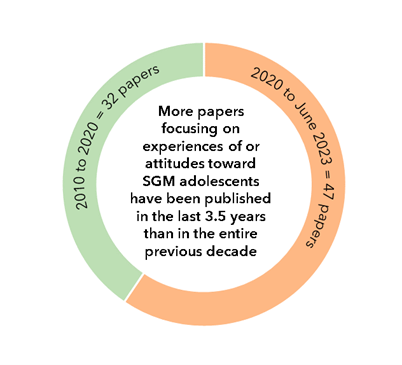We’re Here and We’re Queer: Increasing SGM Representation in Global Health Research and Global Health Researchers
October 4, 2023
This A3 Insights is published under our ‘Youth Perspectives’ series, where Population Council colleagues, fellows, interns, and partners under the age of 30 write a data-driven thought piece focused on their own interests and research areas.
This piece, authored by Cara Frances, former GIRL Center staff who led the creation of the A3 Policy Checklist and current PhD student at Drexel University, explores the health and wellbeing of a critically under-researched population, sexual and gender minority adolescents living in low- and lower- middle- income countries.
Findings from a recent GIRL Center scoping review demonstrate a much needed, growing interest in the health and wellbeing of sexual and gender minority (SGM) adolescents in low- and lower-middle- income countries. More papers focusing on experiences of or attitudes toward SGM adolescents have been published in the last three and half years than in the entire previous decade (2010-2020: 32 papers, 2020-June 2023: 47 papers). This scoping review, authored by me, Jessica DeMulder, and Camille Garnsey, examined research not only where SGM young people ages 10-24 were centered as the priority population, but also research that explored attitudes of cisgender and/or heterosexual people towards SGM populations.
This research area is growing so fast that over the course of this three-year project, the results changed substantially. When we first shared preliminary results in 2021, the majority of papers that had been published did not include SGM young people as participants. Instead, the papers focused on the beliefs and perceptions of students toward SGM populations or the attitudes of healthcare professionals toward SGM youth.

But this summer (June of 2023) when we checked for new publications, we were excited to see an increase in the number of studies that highlighted the lived experiences of SGM young people. Now nearly two thirds of the papers in our review (50 out of 79) included SGM individuals as study participants. Research that centers on the experiences of SGM young people in low- and lower-middle- income countries is crucial to furthering our understanding of their health, wellbeing, and safety needs and ultimately co-developing interventions to address them.
However, while SGM adolescent focused research may be increasing, views on homosexuality worldwide remain divided. While sixty-four UN member states currently criminalize consensual same-sex sexual conduct, 71 states offer same-sex marriage and civil unions. In Uganda, an anti-homosexuality bill that made same-sex sexual behavior punishable by death was signed this year, but in five countries, Antigua and Barbuda, Barbados, St. Kitts and Nevis, Singapore, and the Cook Islands, same-sex conduct was decriminalized.
In the United States and other high-income countries, recent discussions have centered on transgender rights, with 19 states having banned best practice medical care for transgender youth in 2023 alone. At the same time, Finland, Hong Kong, Spain, and Vietnam have all take steps to protect the health of transgender individuals. On the whole, diverse gender expressions and same-sex sexual conduct are more harshly criminalized in low- and lower-middle- income countries than high-income countries. With a growing body of research from high-income countries pointing to an association between the wellbeing of SGM youth and their legislative environments, it is more important than ever that advocates, practitioners, and researchers prioritize the health and safety of SGM youth living in low- and lower-middle- income countries.
Looking Ahead Recent data from the United States suggests nearly 20% of Gen Z young adults identify as SGM, making today’s generation of young people not only the largest it’s ever been, but also the queerest. And while the proportion of individuals who identify as SGM varies around the globe, until we have more accurate and disaggregated demographic data on SGM young people globally, we will not be able to fully assess, let alone address, their health and safety needs. The key to increasing research with SGM young people is the leadership and scholarship of SGM researchers. By involving SGM young people in participatory action research as teens or young adults, we can inspire a new generation of SGM researchers and begin to address the inequities that have long prevailed in the global health field. With thoughtful, intentional design, we can build inclusive research teams that promote the leadership of SGM young people, and ultimately their health and wellbeing too.
Read the scoping review that inspired this piece

Stock photo credit: The Gender Spectrum Collection

 Cara Frances
Cara Frances